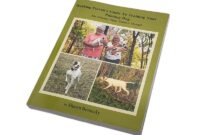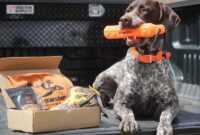Hunting Dog Care – Hunting with your dog is a great way to experience the outdoors with your furry friend. Dogs have been hunted by humans for centuries, and many breeds of animals have been bred to find, clean, or retrieve meat. However, training your dog to be a good hunting companion takes time, effort, and proper guidance.
In this comprehensive guide, we will look at the important steps and techniques involved in training a hunting dog. Whether you are a first-time hunter or a seasoned hunter, this book will help you with tips and tools for training your dog.
Hunting Dog Care

Before you go hunting with your dog, it is important to know what training is appropriate. Training your dog not only helps them become better at finding and finding games but also prepares them for any challenges they may encounter at school. In addition, training allows you to establish a strong relationship with your dog and ensure that he is safe during the hunt. By taking the time to train, you can improve your dog’s skills and create a happy hunting team.
Pet Care Guides & Gear For Active Dogs In The Outdoors
Guns can be loud and startling to dogs, causing them to panic and run away during hunting. Therefore, it is important to train your dog to hunt together. The idea is to gradually teach your dog the keys by adding them to the training.
Start with a selective shot as the dog leaves to retrieve it. With each shot, the shooter must move the carrier and dog slowly. Encourage your dog with praise or training when he is comfortable with the sound of horns. This gentle technique will help your dog associate words with positive experiences and gradually reduce their fear or anxiety.
The act of listening is the foundation of all other learning methods. A well-trained dog must follow basic rules such as sit, stay, and remember. These basic rules provide the necessary guidance to guide your dog through the joys of hunting. Start teaching your dog to obey regularly from a young age, around eight weeks. This will help them develop the necessary skills and physical abilities needed to handle challenging training jobs in the future.
To teach your dog to find and clean up game, consider adding quartering training to your training. In quartering training, dogs are trained to walk in a circle in front of their owner. This pattern helps them to cover ground and find game rather than just walking straight. Set up bumpers or tags to guide your dog in this direction, and use small hands to guide their way. Remember to praise or reward your dog after every successful lesson. Check out this great training video from Lone Duck Outfitters & Kennels.
Of The Healthiest Dog Breeds
Game hunting is an important skill for hunting dogs, and proper training is essential to be able to successfully hunt game in a variety of environments. Start by matching the search using tricks or exercises. Repeat the training on land and water to help your dog in different areas.
For example, you can throw a baby bird in a box in the air, if the bird falls, and get your dog. These exercises help your dog learn to locate and retrieve fallen birds.
Blindfolding is an important part of photography. It’s about leading your dog to a falling bird so he doesn’t see it fall. This requires intense training to teach your dog to respond to keys or hand signals. By doing blind training, your dog will become adept at finding and retrieving game even though he cannot see the birds falling.

Before you go hunting, it is important to evaluate your dog’s hunting skills and encourage their training through various activities and experiments. Participating in Retriever Field Trials and hunting trials, such as those organized by the American Kennel Club (AKC), can provide insight into your dog’s performance at school.
Why Your Dog Needs An Orthopedic Bed
These events are designed to showcase the skills and qualities of a dog depending on their breed, whether they are Pointers, Retrievers, or Spaniels. Participating in these activities will not only help test your dog’s hunting skills but also make them active and presentable in the outdoors.
Also, it is important that you provide your dog with the necessary equipment to ensure comfort and safety. You may consider including items such as basic equipment, including bandages and pain relievers. Additionally, when hunting for water, a coat can provide additional protection for your retriever.
Other important things include keeping blinds or raised areas to protect your dog from the elements and provide them with a warm and safe place. Bringing cleaning products to wash your dog early at school can help prevent unwanted odors in the event of an accident with a skunk. Finally, don’t forget to dress your dog in a bright orange safety vest to ensure that it can be recognized in the event of a seizure.
When thinking about training a hunting dog, it is important to choose the right breed that fits your interests and lifestyle. Different species are suitable for hunting different animals, such as land animals, waterfowl, or hunting. Other popular hunting dogs include Labrador Retrievers, German Shorthaired Pointers, Golden Retrievers, and English Springer Spaniels.
Pro Hunting Dog Breeder Standard Of Care Bill, Hearing Jan. 22
It is important to research the characteristics of different hunting dogs to find one that fits your needs. Remember that each breed has a different personality, and choosing the right breed for hunting dog training is important.
Training a hunting dog requires patience, dedication, and a deep understanding of your dog’s needs. Here are some tips to keep in mind:
Training a hunting dog is a rewarding and rewarding opportunity that requires dedication, patience, and a true love of the sport. By following the steps outlined in this guide, you can lay the foundation for a smart and reliable hunting partner. Remember to prioritize your dog’s well-being and safety during training, and always seek professional advice if necessary. With the right training and proper care, your hunting dog will be a valuable companion on your outdoor adventures.

They offer a diet recommended for your hunting dog so be sure to check out all the ingredients in our originalandpremiumdog food, made in our family kitchen located in the USA! Use these tips from Dr. Gracey Welsh to keep your gun safe. Dog after hunting.
Best Hunting Dogs
The moment your dog goes into the hiding place or into the water on command to get the desired reward is a surprise for both the owner and the dog. Everyone’s adrenaline is pumping and they are so focused on their goal that sometimes injuries are not noticed until it is too late. I always recommend allocating 5-10 minutes to each dog to look at them before leaving and leaving after the work session. This is an important recording time and can catch the right problems, which leads to a better and faster process.
Begin by testing the tip of each dog’s toe, each time before your dog enters the kennel. Open the mouth, raise the lips and look at the mouth. Look for broken teeth, blood clots or other things in the mouth. Pay attention to the color and see the change to ‘normal’ for your dog. Broken teeth are often painful and can lead to infection. But the sooner it is done, the more these problems can be avoided. I often find bark, grass, or debris between the teeth. This is a good time to remove these substances from the mouth. Then, gradually change the eyelids. Are you looking for reds, releases, or something else? A saline face wash can be used to gently wash away dirt or debris that has accumulated in the eyes. I’m a fan of looks. After all, they are important! Increased redness or itching are warning signs that require a visit to the general practitioner. A quick ear check for fleas, ticks or ticks is a simple task.
Listen: Landscaping and Rehabilitation for Playful Dogs by Dr. Kristina Mott – Project Upland Podcast Episode #37
Place your hands on the dog’s nose and on both sides of its head and neck. This is a good way to detect inflammation or swelling in the area. When found, they must fix it. Continue running your hands from the base of the neck to the end of the tail. Try to shoot the pain, cut, or swelling differently. Long-haired dogs often break the end of their tail and you get blood on the tail, and because of the difficulty of twisting their tail at this time, and on the side of the dog. This would be easy
Tailgate Exam, Part 2: Feet
Best hunting dog crate, hunting dog tracking, hunting dog tracking systems, best hunting dog food, hunting dog beds, hunting dog shock collar, best hunting dog kennels, hunting dog gps tracker, hunting dog training texas, hunting dog gps, hunting dog supplements, hunting dog food
- Search Rescue Dogs - July 29, 2024
- Police Dog Training - July 25, 2024
- Pointing Dog Training - July 25, 2024




